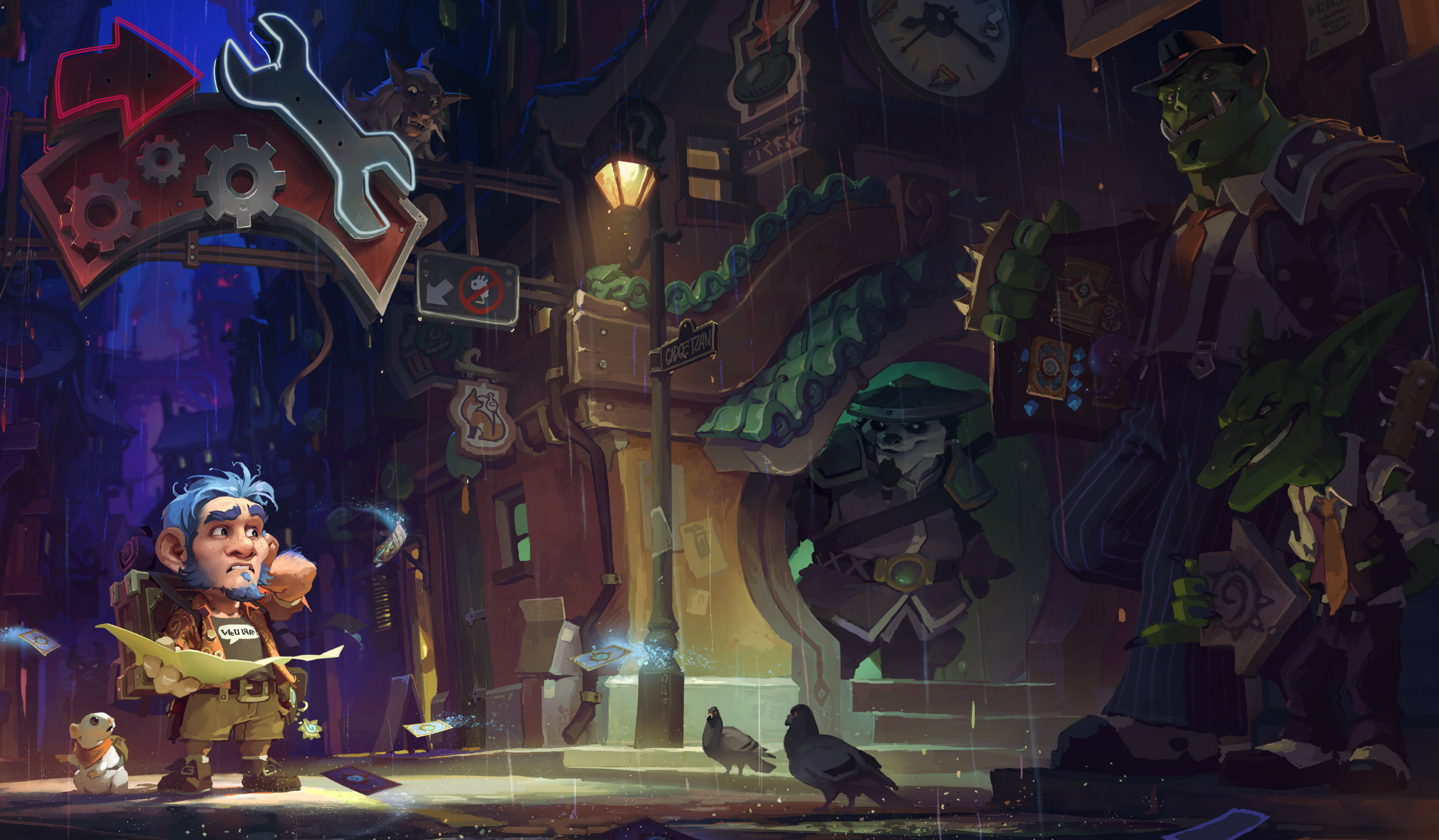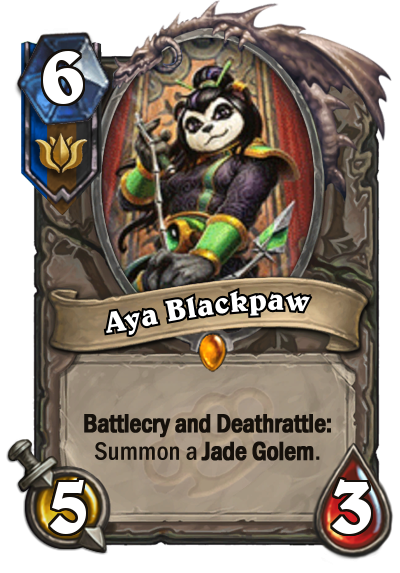Is Mean Streets of Gadgetzan going to be Hearthstone’s first anti-aggro expansion?
According to Simon “Sottle” Welch’s analysis the meta isn’t about to slow drastically.

“This time the meta will slow down for sure”—Hearthstone players, 2016. Of course, they’ve said the same thing before the release of every expansion ever, citing everything from Curse of Naxxramas’ stickier minions (ha!) to The Grand Tournament’s Inspire keyword as the reasoning. Well, I’m afraid I’ve got some bad news. It didn’t happen in 2014, or 2015, and I’m pretty confident it’s not going to happen now. But for the purpose of creating an emotional rollercoaster, let’s start by taking a look at some of the promising signs from The Mean Streets of Gadgetzan for all you optimistic control players out there. After that we’ll get into my soon to be validated—vindicated?—doomsaying.

Sottle is a multi-Legend rank player on team compLexity, tournament winner, and caster who regularly streams on Twitch. He also writes guides for Icy Veins, all while somehow finding the time to be a national Yo-Yo champion.
When the new expansion arrives on December 1, it will bring some great control cards, several of which are for the “Worst Class in the Game”™. Yes, Priest is getting some completely insane tools in terms of board control and stability, which may enable them to finally deal with the never-ending flood of midrange, high-tempo minions that Hearthstone has become famous for.
In that sense this set actually marks a departure from Blizzard’s recent design philosophy, because large AoE spells like Dragonfire Potion and strong Silence effects like Kabal Songstealer have been used incredibly sparingly in recent expansions, and have in fact been purged from the game by set rotation and nerfs.
This is partly an admission from the designers that Priest’s class identity is about being annoying. Anduin is that guy that gets on your nerves, ruins your fun, and steals your girl. It’s also a somewhat patronising nod towards the class. Blizzard seems to be saying that these power tools, which they’ve been so careful with in the past, would be ridiculously destructive in the hands of a top tier class, but like giving an M16 to a kitten, how much damage are they really going to do in Priest? Regardless, Priest has been given some of the best control tools we’ve ever seen, and that has to be a big fat tick in the plus column for a potentially slower meta.
Jackson of all trades
The addition of new Reno-style cards speaks to a similar thing. Reno Jackson is one of the most powerful anti-aggro cards in the game. Played at the right time, he single-handedly crushes the dreams of face-inclined players, leaving them ruefully staring at their lone Wolfrider in hand and re-evaluating their life choices. The problem was that Reno decks really had no upside beyond that one admittedly insanely good card.

Play a 5/5 and get a free Pyroblast on the same turn? Seems good.
The new Kabal gang fixes that by adding cards like Kazakus, Inkmaster Solia, and Raza the Chained, which provide additional benefits for Highlander decks (ie those which only run a single copy of each card, because “there can be only one”). This will mean more stability for Reno decks, and the chance that you’ll queue into other classes outside of Warlock playing the singleton strategy and be forced to treat them with an element of respect rather than bemusement. Crucially, all three classes covered by the Kabal umbrella—Mage, Priest, and Warlock—have also received new AoE options, which are vital to Highlander decks that will by nature fall behind on the board due to their inconsistent curve. Promising signs again! Until Reno rotates out in a few months…
Finally, the mechanics of the other two gangs—the Grimy Goons and Jade Lotus—though more midrange-focused than control, do still encourage a slightly slower setup for their more board-centric strategies. This is the sketchiest pro-control argument for sure, but I’m grasping at straws now. The hand buffing mechanic of the Grimy Goons creates a tension between tempo and value that will slow down their early minion development. They will have to take slow turns at first in order to set up power turns later, and this gives control decks time to draw the answers that they need.
Keep up to date with the most important stories and the best deals, as picked by the PC Gamer team.
Jade Golem decks are likely to curve out more consistently than control decks.
Jade Lotus decks, on the other hand, will scale linearly, but perhaps not rapidly, towards the late-game, thanks to those ever-growing Jade Golems. There’s a very clear relationship between the exponentially bigger threats of Jade Lotus decks and the variously-powered removal cards of control decks. The problem is that the Jade Golem deck is likely to curve out more consistently than the control deck, and the moment that the control deck fails to line up that perfect answer the Jade Lotus player will smell blood and go in the for the kill. Still, these two crime families are tentatives ticks in the plus column for a slower meta.
Me no go slow
So, why won’t the meta slow down? Well, we talked about this in my article dissecting the problems with Priest, and I can more or less just copy and paste from that. Hearthstone is a tempo-focused game, and this is true at a level way beyond any individual cards that you print. The fact that the attacker dictates the play in Hearthstone, coupled with the fact that the “defending” player has no form of interaction during their opponent’s turn, means that being ahead on board just provides you with way more options than your opponent has at any given point.
The meta will always be determined by the most powerful decks that are able to grasp initiative on board.
In Hearthstone, the player with initiative always controls the pace of the game. This is a slap in the face to the very idea of a “control” deck. The aggressor in a matchup dictates the rhythm of trades on every turn. They decide whether to let the status quo continue, or whether to push harder and ask for more key removal cards from their opponent. The control deck really has little input in this equation, and simply has to rely on having the right answers and being switched on enough to identify the right moments to react to the questions being asked by the aggressor.
When you boil everything down, it means that the meta will always be determined by the most powerful decks that are able to grasp initiative on board. Yes, control decks have space to exist in the meta, but they do so because they’re built as a reaction to what the board-grabbing decks are doing. Control decks rarely—if ever—dictate what the meta looks like or force aggressive decks to react to them.

Don't sleep on the potential power of Patches in an aggresive pirate deck. Arrrgh, etc.
Even beyond that existential argument, actually digging down into the Mean Streets cards, I just don’t see a slowdown happening. Firstly, let’s quickly deal with the eye-patched elephant in the room: Pirate Warrior. This was an already playable deck, and it’s going to receive a huge buff in Mean Streets thanks to cards like Patches the Pirate, Small-time Buccaneer, and Hobart Grapplehammer.
The fact that there is obviously going to be an aggro deck with a super high power level in the expansion means that pure control decks already have difficult deckbuilding questions to answer. What good is your Reno Jackson if you’re lying on your back staring up at a bunch of rum-swilling swashbucklers as early as turn five? The pirates aren’t coming alone, either. Aggro Paladin is set to be reinvigorated with a new resource engine and early-game power in the form of cards like Small-Time Recruits and Smuggler’s Run.
Precious jade
To make matters worse, if you now aim your beloved control deck at dealing with relentless aggro, well, here come the Jade Golems! Jade Golems, despite my earlier platitudes, are probably the biggest terror to control decks. If Control Warrior were to become dominant, a single Jade Idol teched into Druid could quickly put a stop to that nonsense.
This means that “pure” control, in terms of trying to eliminate all of your opponent’s threats, is going to be hard to pull off. Which in turn means that control decks will need to play win conditions of their own—think Alexstraza and Grommash Hellscream in our Warrior example—to grasp the initiative back in the late-game. However, as soon as you start to including these expensive cards, you open yourself up to the risk of drawing a clunky hand which lacks answers, and, well... you die.

Aya is running a buy one get one free offer on Jade Golems this holiday season.
The bottom line is that Hearthstone is fundamentally a midrange kind of CCG—and honestly that’s fine. It’s something that people really need to come to terms with, because it’s not likely to change with this or any other expansion. As I’ve discussed before, there’s no inherent right to play control. There’s nothing about control decks that make them somehow more pure or noble than decks built around aggressive strategies.
The problem with some of the most stale previous Hearthstone metas was that the best decks were just too simple to play. Too often, all the player had to do was develop the maximum amount of power on board that their mana allowed each turn.
Mean Streets at least seems to be trying to move away from that, with many of the strong board presence strategies involving some sort of tradeoff of short term power in exchange for long-term value. So my message is be prepared for a shake-up, but don’t push your chips all-in on Anduin just yet.

